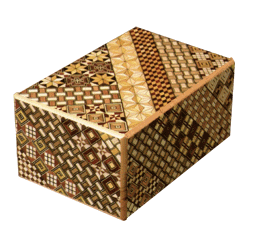|
|
|
If you appreciate fine woodwork then you'll like
these, they are hand made in Japan and the fit of the jointing is superb,
they look to be a solid block of timber when closed. The decoration on
the example shown below is not just a printed pattern, it's marquetry,
the pattern is made up of thousands of tiny interlocking pieces of various
timbers. The example shown below only requires five moves to open it, but
more complex boxes can be had, some requiring up to 66 moves to open.

These were the first electronic wristwatches, the hands are driven directly
by the vibrations of a tuning fork inside them. They were made from 1960
to 1977, the model shown below is a Cal. 214 "Spaceview", which was sold
with no face in order to show off the interesting and unique movement inside.
These watches don't tick, they hum, if you put one to your ear you can
hear a slight hum and you can also feel a slight vibration from them if
you hold one between your fingertips. The second hand of these watches
does not step around the dial in one second steps as is usually the case,
instead it moves smoothly around with no noticeable steps. The more desirable
214 models do not have a setting stem on the side of them, as they are
'back set', there being a toggle on the back of the watch for setting them,
making them an ambidextrous wristwatch.
There is an Accutron 214 on the Moon, having been left there by Apollo
11 astronauts.